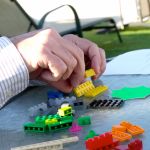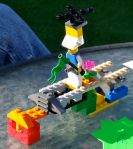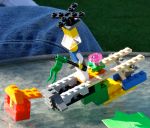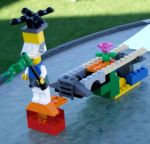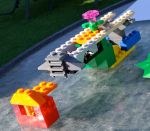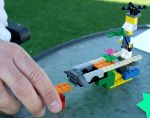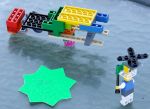JK is an experienced business consultant from Israel. He is curious about this LegoView thing. I don’t waste too much time and get straight into the issue. What is Israel? – I ask him. He looks at me and at the bricks. ‘The question is tough!’ he says still puzzled, trying to make his mind while starting building his model.
“Israel, as you can see, has a lots of parts within it… We have the sea, which is the blue part, we have the desert, which is the yellow, and we have the green, which is the forest and the wildlife and a flower here, and the orange is some colourful nature parts. We have our urban landscape and houses, which are the grey and the black bricks. You see – he shows me immediately – the structure is not very stable… it’s linked to some hazardous parts, which is the orange and the red… – he says pointing me out the little red and orange structure which lies next to the end of his model: it’s attached yet separate.‘So what is that?’ I ask him. ‘This is the hazard part of our life – he says – and it’s a substantial part of our life because you see that if you move it, the whole structure falls… So. it’s linked to us, maybe it’s even holding us, but if you move it, there’s the risk that the whole structure would bend, maybe not collapse, but bend. And there’s a ladder – he says pointing at the grey brick – we have to consider to use it or not to use to actually connect these risks.’
Than he looks at the human figure and explains it: ‘And on the top of this structure stands the Israeli with his flag. Maybe it’s a bit peculiar in the structure, considering himself to be a high flier but if he flies off this structure, maybe the balance would be affected.’ Then he shows me the little yellow bricks with some rounded shapes on the head of the human: ‘He has eyes on his back so he can look backwards because he is in a dangerous area, he has to look everywhere all the time. But the contradiction is that even though he is high and highflier and has eyes in the back, he has not enough vision to see what’s going on all around him – not only in his neighborhood, but everywhere else around the world. He thinks he does, but the question is an open question…’
Are we still talking about the model? The model and the metaphors are now taking the conversation to a completely different level. I sit in front of JK, we are both relaxed and at ease, and I simply listen to him and let the bricks to guide the conversation.
‘The hazard part is a very complex part… It’s linked maybe even more deeply than it seems and has a big effect on the stability of the structure. There’re a lot of components of this hazard: maybe it looks small compared to the structure, but the size is compensated by the effect: you move it and ooops!… the structure changes.’ And by saying so he moves the red block away and the model loses its stability. ‘Intuitively you can think of the ladder as a connection to the hazard to keep everything working as long as you use the ladder, once the ladder is not needed you remove it and this effect happens…’ And again he takes the ladder off and again the model loses stability. At this point I am fascinated: JK is completely engaged in the process and there’s a very deep interplay between JK and the bricks. ‘And the hazard is very complex because it’s an internal hazard but it’s also an external hazard.’ I notice that the human figure he put at the centre of the model is quite distant from the hazard, it’s looking at the hazard from faraway, from a higher position.
‘I think the Israeli has the perception that he has the ability and it’s strong enough to cope with the hazard. At the beginning I’ve thought to put him here – and by saying so he moves the human figure just on the front of the model, next to the hazard – but this would have caused a major stability issue. And this rise the question: will he really cause a major stability issue? Maybe if we put him on the hazard itself then stability would be better…’
I noticed a grey brick which was between the legs and the upper pat of the body and ask JK about that. ‘The brick with this gun you mean?… ‘ he says ‘…The first think I’ve thought it’s about protection, something he can use to protect himself from the risks of the hazards he has around…’ But I have to better understand what this hazard is about. ‘The hazard and the risk is a major brick in our lives in Israel, because we always feel everyone is against us, which is, I think, quite realistic and it’s true. We have only one friend, America, which is very far away, and that’s why we feel we have to take a lot of precautions and protect ourselves, so that we can continue to exist in this region. That’s why we maybe need some unique things like this propeller, so that we can fly. We are very proud of what we have achieved, which is represented by the flag that we are hold in our hands: it’s the Shield of David which once was stapled on us and lead people to the gas chambers and now it’s in our hands.’ ‘And where does the hazard come from?” I ask JK ‘I see Israel, the land and the cities… But the hazard seems detached, external from the country…’ ‘It’s attached in a way that is present, it’s a major issue, and although it does not look very big, it has a big significance. And it’s interesting that even when you detach it, the structure exist, it does not collapse, it stays intact but in a very different way…’.
JK focuses on the instability and I can’t resist asking him about how this instability could be solved. Both me and JK are now completely immerse in his model – we are talking about the model, I never ask a question which is not about the model, though the concepts are getting more complex and abstract. ‘I think that detachment is inevitable from what you see in this structure… If this person is willing truly to stand on the hazard or connect with it, maybe stability would be better. The whole picture would be bigger – when you move it, – he says by taking the hazard away – something is missing. We don’t know what is the meaning of this missing part: is it contributing? Is there’s a synergy between Israel and its hazard or not? And maybe the best solution is what we see here: detachment. It’s not very beautiful though…’.
He starts playing around with the human shaped brick: he takes it away from the model, puts it in different positions, until he takes that it out from the model: ‘…If I try to remove this person … everything is balanced‘. I look at this model: so, the problem are people? ‘The problem is always the people!’ He says laughing. JK keeps playing with the bricks: he then takes out the grey brick representing the gun and looks at me: ‘See what happens without the gun…’ and while saying it he places the gunless figure back into its original position: ‘Better!’
We stare amazed: the model was perfectly balanced, like all the problems were caused by that small grey brick. ‘That says that if you defuse the whole middle east from the arms, but it has to be from everyone, not only from Israel, of course everything would be more stable.’
The LegoView is getting intense and I turn my attention to the ladder. ‘This ladder has a very crucial function here and as we see the person is not very close to the ladder now…’ But I see a further problem in JK model: the human figure is not only distant, but he can hardly reach the ladder because of an empty space in front of him. ‘He has to cross a black hole before he reaches to the ladder.’ he admits. ‘We could put the figure also on the other side, and see the person that has to climb down the ladder and the hazard has to climb up the ladder and it might be a little bit more difficult… maybe it’s easier to climb down than to climb up… Which is also an interesting interpretation…’ And by saying so he moves the figure on the hazard and start something none ever did before: a reverse interpretation of the model. I follow JK and his bricks and ask him what’s the exact meaning of climbing up and climbing down. ‘It means different types of efforts… If we go on with the reverse interpretation we can reverse everything and say that this is Israel’ he says pointing at the red block – ‘… this is…. everything else… The rest of the world. And then everything changes and we see the very strong and substantial world surrounding a small but very observable country. It’s very small but it’s very seen. Or it thinks it’s very seen. I am not sure what’s going on in Europe, I know that in the United States Israel is totally out of its size if you look at the media, the public discussions, especially now because of the presidential race all candidates and israel is becoming a very important issues in the campaign…’ Since we engaged in this reverse interpretation of the model, I ask JK who is the human shape now? ‘This Human, judging from where he is standing, is the neighbor of Israel and he is standing in front of the same black hole which he needs to overcome to make a move towards Israel and connecting with Israel…’ ‘There’s a gap which has to be overcome between this neighbor and Israel. This gap is made of believes, prejudice, perceptions – I’d say unrealistic perceptions – dreams and actually it’s the same… maybe this is the common thing between the two sides, whoever they are, Israel and the neighbors …’
‘Where does these perceptions and dreams come from?’
‘I think they come from a combination of history, religion, politics and it’s a very complex formula. And there’s also another interesting question: what is Israel for the world, not only its neighbors… What purpose does it serve? What would happen if there was not this creature called Israel that you can always throw mud at it, you can always vote against in the UN… What is this container called Israel?’. I take the challenge and referring to the reverse interpretation, I tell JK that if we would take the red bricks out of the model, after all the model would be still be there, quite stable in its way. He laughs. ‘Maybe it would be kind of ok, but something would be missing. Something very colourful so to speak…’.
‘There’s this dark area, with the grey ladder, the bridges, the black platform… what is that?’ ‘Initially it was to portray the place we live in, our residential areas, but I think it’s taken now a different meaning, because you have to cross this black area to reach each other… So this black area has maybe an unconscious meaning: crossing something which is unknown, maybe you don’t exactly see where you’ll end after you’ll cross it and what will happen…’ He keeps playing with the bricks and he takes the the grey brick representing the gun back into the human figure and places it back. We are both surprised, as this time the model is balanced. We laugh amazed: ‘I tell you why it works now: before the person was leaning a little bit too forward…’
Me and JK are learning from the bricks. We are talking about very complex social realities in a playful and light way; there are no tension, we are both engaged in the LegoView process together, we are building new meanings and concepts together: me, JK and the bricks.
‘How should we regulate the human not to lean too much and what does leaning mean?’ ‘Maybe
leaning is a way to show an intent, but leaning can change the whole situation dramatically… and if you move the human here – he says moving the figure in the back of the model – the structure can stay balanced actually , and even if you move it here – he says while taking the figure in the front -’but if you lean too much again it would fall…’ And about the reverse version? ‘in the revers version doing something, maybe unthoughtful things, can lead to totally new situation which
are feasible and were not thought before…’ And by saying so he takes the model and puts it upside down. But in this way, in the upside down model, everything is relying on two main bricks: nature and the hazard. ‘It seems you can’t live without the hazard…’ I ask JK. He keeps playing with the model. ‘In a way, yes… We have to do some changes in the structure or live with a structure which has no ladder’.
JK and I went on playing further with the bricks, revealing concepts and analysing the Israeli situation. LEGO bricks enhanced our meaning-making processes, lead the conversation, portrayed Israel and its hazard, as JK referred also to Palestine. He never mentioned Palestine though. But when I have asked him to build a model of Palestine, he knew what to do.
Me and JK were equally involved in the constructivist process which LEGO made it appear light and the whole LegoView experience was playful, easy and yet intense, despite the weight and the substance of the questions and the issues at hand. We were surprised – surprised both by the bricks’ power and by the process itself. We had a very intense conversation, yet, rather than being it draining and tiring, it was an exciting discovery. Because LEGO made actually easy to face complex realities and discover new meaning and new insights. Easily and lightly in brand new maieutic process.

